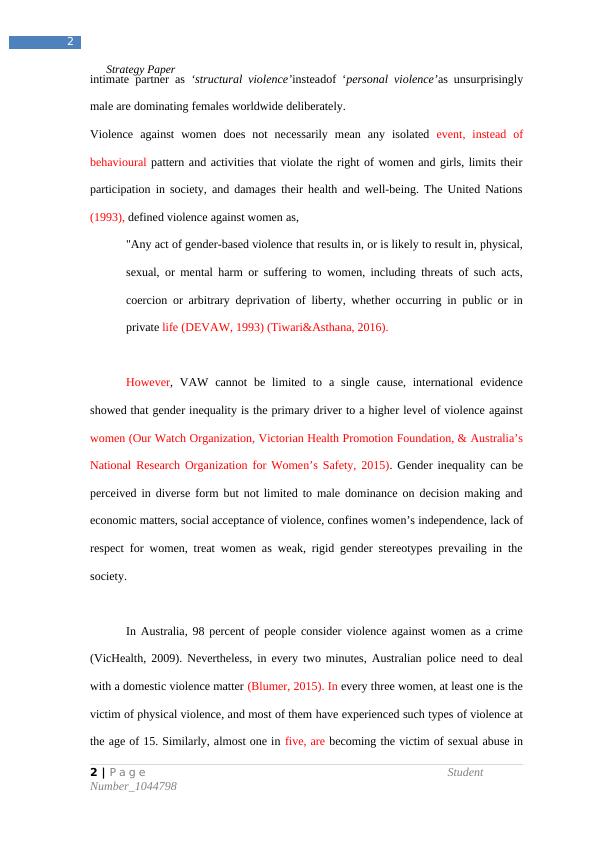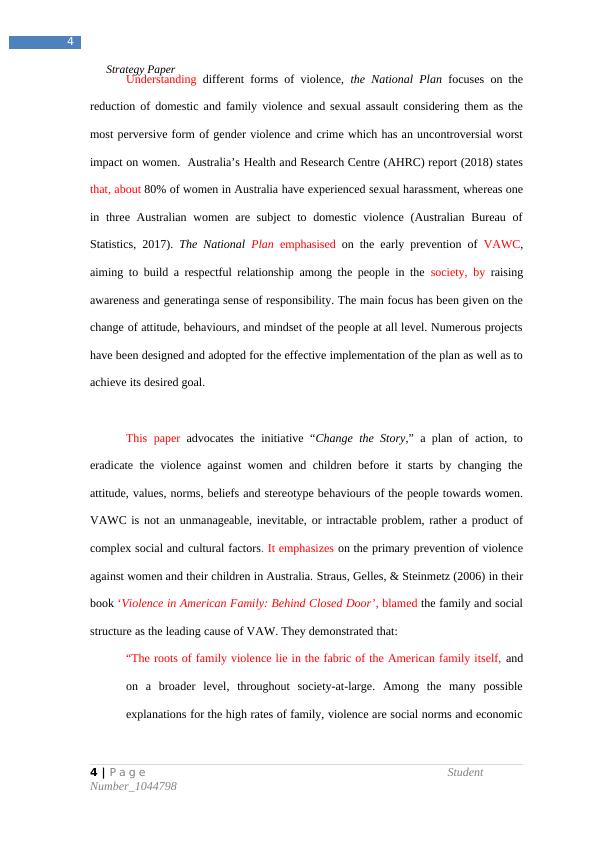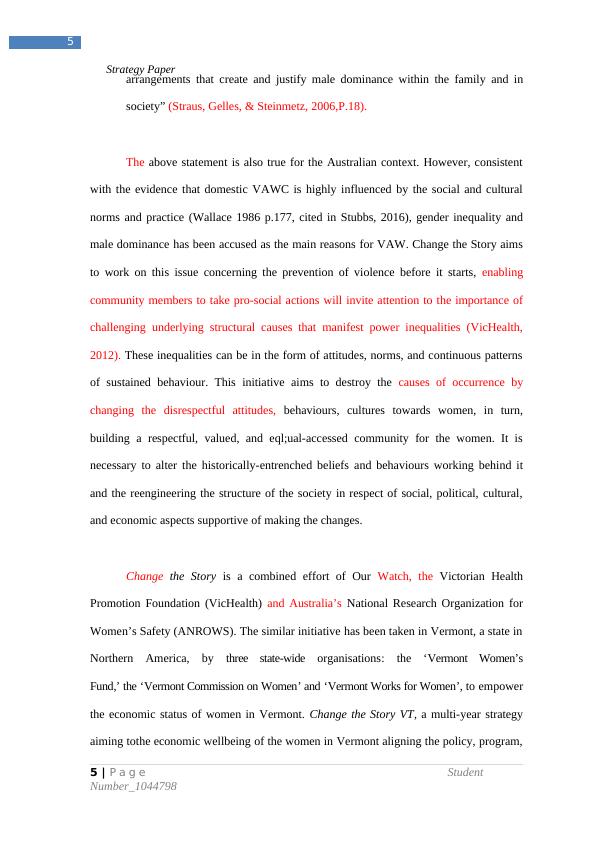Change the Story Framework to Reduce Violence against Women and Their Children
Added on 2022-12-27
29 Pages8724 Words50 Views
PPMN90006
Strategy Paper
The National Plan to Reduce Violence against Women and
Their Children
Farjana Alam
6/11/2019
Strategy Paper
The National Plan to Reduce Violence against Women and
Their Children
Farjana Alam
6/11/2019

1
Strategy Paper
“Change the Story Framework” to reduce violence against women and their children
Part A: Background and Context
Violence against women and children (VAWC) has been blamed as the most
perversive violations of human rights and one of the least prosecuted crimes (Puri, 2013;
S.J., 2017). It has been identified as a great threat to global peace and development
(ibid). In the opening speech, at ACP-EU parliamentary assembly on Ending Violence
against Women and Children, Lakshmi Puri (2013) as an acting Head of United Nation
(UN) uttered the words concerning the severity of the crime. The interim mayor of
Hlatikulu Maduduza Zwane repeated the dialogue at the time of delivering his speech, at
the march organised by the nation’s Justice and Peace Commission, in Manzini, against
gender-based violence on 1 July 2017, said the dialogue, appealing VAWC as global
crisis affecting all the countries in the world.
However, VAWC is neither a new phenomenon nor confined to any jurisdiction.
It is a global problem affecting approximately one-third of women worldwide (WHO,
2013, p-35). Incontrovertibly, women, all over the world irrespective of culture and
country, are the worst victims of violence. According to García-Moreno et al. (2015),
Violence Against Women (VAW) is a globally accepted phenomenon, but historically
ignored and suppressed.‘Turning of the head’ and ‘closing of eyes’ are prevailing attitude
considering domestic violence as a private matter. Cries for justice of women had been
ignored from the very beginning of the civilisation, accepting women as a subject of
dominance (Sinha, Gupta, Singh, & Srivastava, 2017). Evidences showed that, we
structured our society in such a way, that women have been subjugated, subordinated,
dominated, and oppressed. Conversely, Galtung (1969), remarked VAW by their
1 | P a g e Student
Number_1044798
Strategy Paper
“Change the Story Framework” to reduce violence against women and their children
Part A: Background and Context
Violence against women and children (VAWC) has been blamed as the most
perversive violations of human rights and one of the least prosecuted crimes (Puri, 2013;
S.J., 2017). It has been identified as a great threat to global peace and development
(ibid). In the opening speech, at ACP-EU parliamentary assembly on Ending Violence
against Women and Children, Lakshmi Puri (2013) as an acting Head of United Nation
(UN) uttered the words concerning the severity of the crime. The interim mayor of
Hlatikulu Maduduza Zwane repeated the dialogue at the time of delivering his speech, at
the march organised by the nation’s Justice and Peace Commission, in Manzini, against
gender-based violence on 1 July 2017, said the dialogue, appealing VAWC as global
crisis affecting all the countries in the world.
However, VAWC is neither a new phenomenon nor confined to any jurisdiction.
It is a global problem affecting approximately one-third of women worldwide (WHO,
2013, p-35). Incontrovertibly, women, all over the world irrespective of culture and
country, are the worst victims of violence. According to García-Moreno et al. (2015),
Violence Against Women (VAW) is a globally accepted phenomenon, but historically
ignored and suppressed.‘Turning of the head’ and ‘closing of eyes’ are prevailing attitude
considering domestic violence as a private matter. Cries for justice of women had been
ignored from the very beginning of the civilisation, accepting women as a subject of
dominance (Sinha, Gupta, Singh, & Srivastava, 2017). Evidences showed that, we
structured our society in such a way, that women have been subjugated, subordinated,
dominated, and oppressed. Conversely, Galtung (1969), remarked VAW by their
1 | P a g e Student
Number_1044798

2
Strategy Paper
intimate partner as ‘structural violence’insteadof ‘personal violence’as unsurprisingly
male are dominating females worldwide deliberately.
Violence against women does not necessarily mean any isolated event, instead of
behavioural pattern and activities that violate the right of women and girls, limits their
participation in society, and damages their health and well-being. The United Nations
(1993), defined violence against women as,
"Any act of gender-based violence that results in, or is likely to result in, physical,
sexual, or mental harm or suffering to women, including threats of such acts,
coercion or arbitrary deprivation of liberty, whether occurring in public or in
private life (DEVAW, 1993) (Tiwari&Asthana, 2016).
However, VAW cannot be limited to a single cause, international evidence
showed that gender inequality is the primary driver to a higher level of violence against
women (Our Watch Organization, Victorian Health Promotion Foundation, & Australia’s
National Research Organization for Women’s Safety, 2015). Gender inequality can be
perceived in diverse form but not limited to male dominance on decision making and
economic matters, social acceptance of violence, confines women’s independence, lack of
respect for women, treat women as weak, rigid gender stereotypes prevailing in the
society.
In Australia, 98 percent of people consider violence against women as a crime
(VicHealth, 2009). Nevertheless, in every two minutes, Australian police need to deal
with a domestic violence matter (Blumer, 2015). In every three women, at least one is the
victim of physical violence, and most of them have experienced such types of violence at
the age of 15. Similarly, almost one in five, are becoming the victim of sexual abuse in
2 | P a g e Student
Number_1044798
Strategy Paper
intimate partner as ‘structural violence’insteadof ‘personal violence’as unsurprisingly
male are dominating females worldwide deliberately.
Violence against women does not necessarily mean any isolated event, instead of
behavioural pattern and activities that violate the right of women and girls, limits their
participation in society, and damages their health and well-being. The United Nations
(1993), defined violence against women as,
"Any act of gender-based violence that results in, or is likely to result in, physical,
sexual, or mental harm or suffering to women, including threats of such acts,
coercion or arbitrary deprivation of liberty, whether occurring in public or in
private life (DEVAW, 1993) (Tiwari&Asthana, 2016).
However, VAW cannot be limited to a single cause, international evidence
showed that gender inequality is the primary driver to a higher level of violence against
women (Our Watch Organization, Victorian Health Promotion Foundation, & Australia’s
National Research Organization for Women’s Safety, 2015). Gender inequality can be
perceived in diverse form but not limited to male dominance on decision making and
economic matters, social acceptance of violence, confines women’s independence, lack of
respect for women, treat women as weak, rigid gender stereotypes prevailing in the
society.
In Australia, 98 percent of people consider violence against women as a crime
(VicHealth, 2009). Nevertheless, in every two minutes, Australian police need to deal
with a domestic violence matter (Blumer, 2015). In every three women, at least one is the
victim of physical violence, and most of them have experienced such types of violence at
the age of 15. Similarly, almost one in five, are becoming the victim of sexual abuse in
2 | P a g e Student
Number_1044798

3
Strategy Paper
their lifetime in Australian (Australian Bureau of Statistics, 2006; Mao, 2019). Weekly
on an average, at least one woman is being murdered by her intimate (current or former)
partner in Australia (Bryant &Bricknall, 2017). Predictably, VAWC leads not only the
social and psychological impact on society instead also has significant economic
forfeitures. KPMG estimated that in 2015-16, Australia counted approximately $22
billion concomitant to VAWC (KPMG, 2016). Addressing the severity of the problem
Council of Australian Governments referred to domestic, family, and sexual violence as
“a national emergency”(COAG National Summit, 2018). To combat the problem, the
National Council of Australian Government prepared the ‘National Plan to Reduce
Violence against Women and their Children 2010-2022’ (The National Plan), as a part of
their commitment to building a safe, secure and violence-free community for women and
their children (Australian Government, 2009).
This is a comprehensive strategic framework, that aims to deliver a significant and
sustainable reduction in domestic violence. It aims to connect a range of works and
initiatives undertaken by the Government, community organizations, and individuals. The
Plan will be delivered through four three-year Action Plans. It identifies six outcomes
areas indicative of its multi-dimensional approach: communities are safe and free from
violence; relationships are respectful; services meet the holistic needs of women and their
children experiencing violence; justice responses are valid, and perpetrators stop their
violence and are held to account. The Plan is a systematic target-based initiative of
Government towards significant reduction of violence against women and children (The
National Plan to Reduce Violence against Women and their Children, 2010–2022).
“Change the Story” Framework
3 | P a g e Student
Number_1044798
Strategy Paper
their lifetime in Australian (Australian Bureau of Statistics, 2006; Mao, 2019). Weekly
on an average, at least one woman is being murdered by her intimate (current or former)
partner in Australia (Bryant &Bricknall, 2017). Predictably, VAWC leads not only the
social and psychological impact on society instead also has significant economic
forfeitures. KPMG estimated that in 2015-16, Australia counted approximately $22
billion concomitant to VAWC (KPMG, 2016). Addressing the severity of the problem
Council of Australian Governments referred to domestic, family, and sexual violence as
“a national emergency”(COAG National Summit, 2018). To combat the problem, the
National Council of Australian Government prepared the ‘National Plan to Reduce
Violence against Women and their Children 2010-2022’ (The National Plan), as a part of
their commitment to building a safe, secure and violence-free community for women and
their children (Australian Government, 2009).
This is a comprehensive strategic framework, that aims to deliver a significant and
sustainable reduction in domestic violence. It aims to connect a range of works and
initiatives undertaken by the Government, community organizations, and individuals. The
Plan will be delivered through four three-year Action Plans. It identifies six outcomes
areas indicative of its multi-dimensional approach: communities are safe and free from
violence; relationships are respectful; services meet the holistic needs of women and their
children experiencing violence; justice responses are valid, and perpetrators stop their
violence and are held to account. The Plan is a systematic target-based initiative of
Government towards significant reduction of violence against women and children (The
National Plan to Reduce Violence against Women and their Children, 2010–2022).
“Change the Story” Framework
3 | P a g e Student
Number_1044798

4
Strategy Paper
Understanding different forms of violence, the National Plan focuses on the
reduction of domestic and family violence and sexual assault considering them as the
most perversive form of gender violence and crime which has an uncontroversial worst
impact on women. Australia’s Health and Research Centre (AHRC) report (2018) states
that, about 80% of women in Australia have experienced sexual harassment, whereas one
in three Australian women are subject to domestic violence (Australian Bureau of
Statistics, 2017). The National Plan emphasised on the early prevention of VAWC,
aiming to build a respectful relationship among the people in the society, by raising
awareness and generatinga sense of responsibility. The main focus has been given on the
change of attitude, behaviours, and mindset of the people at all level. Numerous projects
have been designed and adopted for the effective implementation of the plan as well as to
achieve its desired goal.
This paper advocates the initiative “Change the Story,” a plan of action, to
eradicate the violence against women and children before it starts by changing the
attitude, values, norms, beliefs and stereotype behaviours of the people towards women.
VAWC is not an unmanageable, inevitable, or intractable problem, rather a product of
complex social and cultural factors. It emphasizes on the primary prevention of violence
against women and their children in Australia. Straus, Gelles, & Steinmetz (2006) in their
book ‘Violence in American Family: Behind Closed Door’, blamed the family and social
structure as the leading cause of VAW. They demonstrated that:
“The roots of family violence lie in the fabric of the American family itself, and
on a broader level, throughout society-at-large. Among the many possible
explanations for the high rates of family, violence are social norms and economic
4 | P a g e Student
Number_1044798
Strategy Paper
Understanding different forms of violence, the National Plan focuses on the
reduction of domestic and family violence and sexual assault considering them as the
most perversive form of gender violence and crime which has an uncontroversial worst
impact on women. Australia’s Health and Research Centre (AHRC) report (2018) states
that, about 80% of women in Australia have experienced sexual harassment, whereas one
in three Australian women are subject to domestic violence (Australian Bureau of
Statistics, 2017). The National Plan emphasised on the early prevention of VAWC,
aiming to build a respectful relationship among the people in the society, by raising
awareness and generatinga sense of responsibility. The main focus has been given on the
change of attitude, behaviours, and mindset of the people at all level. Numerous projects
have been designed and adopted for the effective implementation of the plan as well as to
achieve its desired goal.
This paper advocates the initiative “Change the Story,” a plan of action, to
eradicate the violence against women and children before it starts by changing the
attitude, values, norms, beliefs and stereotype behaviours of the people towards women.
VAWC is not an unmanageable, inevitable, or intractable problem, rather a product of
complex social and cultural factors. It emphasizes on the primary prevention of violence
against women and their children in Australia. Straus, Gelles, & Steinmetz (2006) in their
book ‘Violence in American Family: Behind Closed Door’, blamed the family and social
structure as the leading cause of VAW. They demonstrated that:
“The roots of family violence lie in the fabric of the American family itself, and
on a broader level, throughout society-at-large. Among the many possible
explanations for the high rates of family, violence are social norms and economic
4 | P a g e Student
Number_1044798

5
Strategy Paper
arrangements that create and justify male dominance within the family and in
society” (Straus, Gelles, & Steinmetz, 2006,P.18).
The above statement is also true for the Australian context. However, consistent
with the evidence that domestic VAWC is highly influenced by the social and cultural
norms and practice (Wallace 1986 p.177, cited in Stubbs, 2016), gender inequality and
male dominance has been accused as the main reasons for VAW. Change the Story aims
to work on this issue concerning the prevention of violence before it starts, enabling
community members to take pro-social actions will invite attention to the importance of
challenging underlying structural causes that manifest power inequalities (VicHealth,
2012). These inequalities can be in the form of attitudes, norms, and continuous patterns
of sustained behaviour. This initiative aims to destroy the causes of occurrence by
changing the disrespectful attitudes, behaviours, cultures towards women, in turn,
building a respectful, valued, and eql;ual-accessed community for the women. It is
necessary to alter the historically-entrenched beliefs and behaviours working behind it
and the reengineering the structure of the society in respect of social, political, cultural,
and economic aspects supportive of making the changes.
Change the Story is a combined effort of Our Watch, the Victorian Health
Promotion Foundation (VicHealth) and Australia’s National Research Organization for
Women’s Safety (ANROWS). The similar initiative has been taken in Vermont, a state in
Northern America, by three state-wide organisations: the ‘Vermont Women’s
Fund,’ the ‘Vermont Commission on Women’ and ‘Vermont Works for Women’, to empower
the economic status of women in Vermont. Change the Story VT, a multi-year strategy
aiming tothe economic wellbeing of the women in Vermont aligning the policy, program,
5 | P a g e Student
Number_1044798
Strategy Paper
arrangements that create and justify male dominance within the family and in
society” (Straus, Gelles, & Steinmetz, 2006,P.18).
The above statement is also true for the Australian context. However, consistent
with the evidence that domestic VAWC is highly influenced by the social and cultural
norms and practice (Wallace 1986 p.177, cited in Stubbs, 2016), gender inequality and
male dominance has been accused as the main reasons for VAW. Change the Story aims
to work on this issue concerning the prevention of violence before it starts, enabling
community members to take pro-social actions will invite attention to the importance of
challenging underlying structural causes that manifest power inequalities (VicHealth,
2012). These inequalities can be in the form of attitudes, norms, and continuous patterns
of sustained behaviour. This initiative aims to destroy the causes of occurrence by
changing the disrespectful attitudes, behaviours, cultures towards women, in turn,
building a respectful, valued, and eql;ual-accessed community for the women. It is
necessary to alter the historically-entrenched beliefs and behaviours working behind it
and the reengineering the structure of the society in respect of social, political, cultural,
and economic aspects supportive of making the changes.
Change the Story is a combined effort of Our Watch, the Victorian Health
Promotion Foundation (VicHealth) and Australia’s National Research Organization for
Women’s Safety (ANROWS). The similar initiative has been taken in Vermont, a state in
Northern America, by three state-wide organisations: the ‘Vermont Women’s
Fund,’ the ‘Vermont Commission on Women’ and ‘Vermont Works for Women’, to empower
the economic status of women in Vermont. Change the Story VT, a multi-year strategy
aiming tothe economic wellbeing of the women in Vermont aligning the policy, program,
5 | P a g e Student
Number_1044798

End of preview
Want to access all the pages? Upload your documents or become a member.
Related Documents
Criminal Law For Domestic Violencelg...
|9
|2229
|17
Introduction to Domestic Violencelg...
|13
|3264
|23
Domestic Violence: A Global Public Health Issuelg...
|7
|2489
|106
